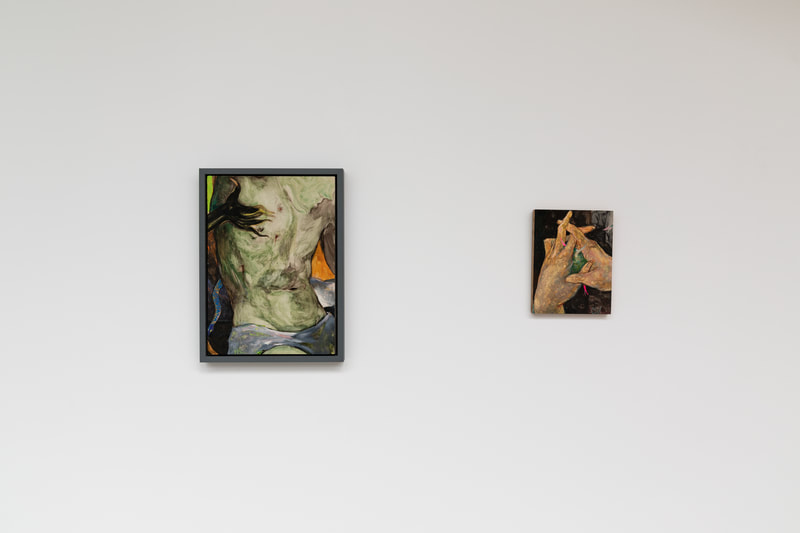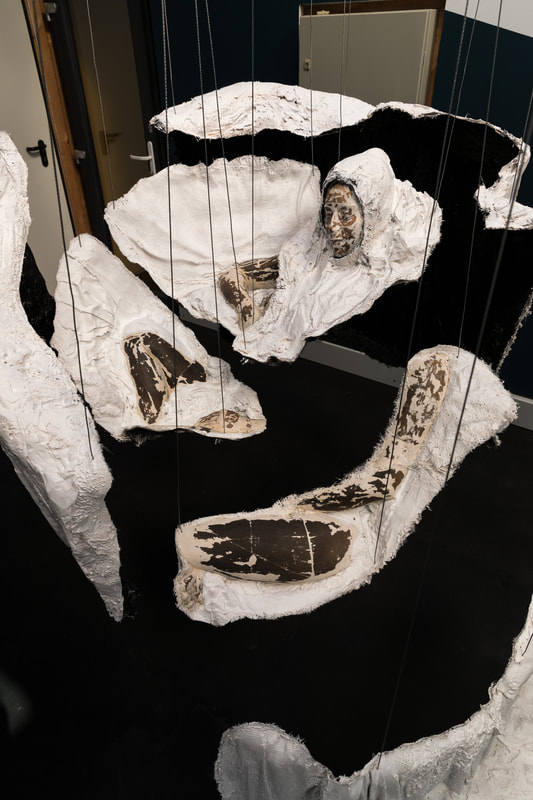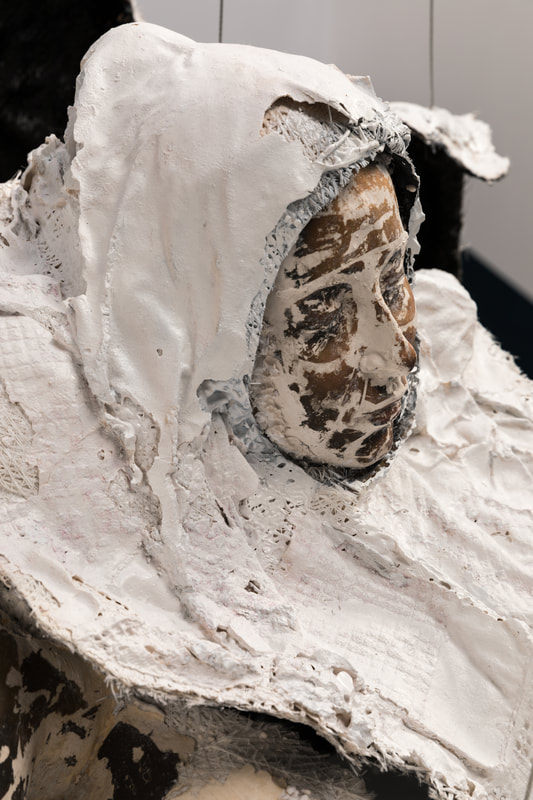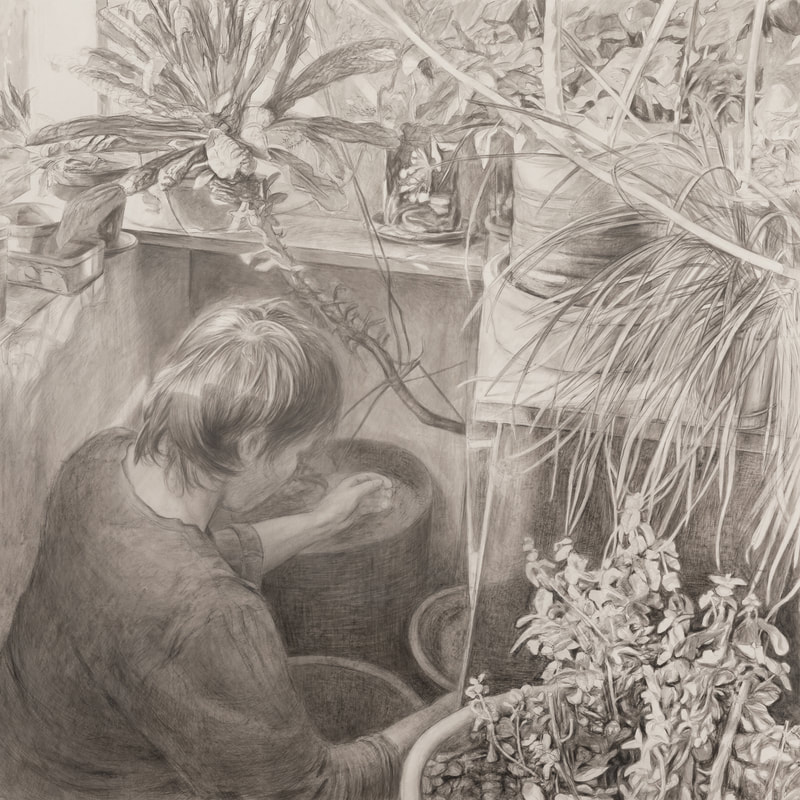STUDIES FOR A BURNING SILENCE
Opening | Saturday, 24 September, 6 pm
Dates | 24 September - 24 October 2022, only Tuesdays & Thursdays, by appointement, between 4 pm - 6 pm
Sunday, 2 October 2022, between 6 pm - 10 pm
Location | Hangar F, 12 Atelierului Street, Alba Iulia 510001, Romania
Curator | Ada Muntean
Artists | Răzvan Neagoe / Dragoș Neagoe / Ada Muntean / Mathias Bar / Ana Maria Micu (in collaboration with Alexandra Constantinescu and Radu Constantinescu) / Mircea Modreanu
One of the most iconic plays of the XX-th century, Waiting for Godot written by Samuel Becket in 1953 (the title paraphrasing the term „waiting for God” from the existentialist philosopher Martin Heidegger) develops into several scenes with no narrative connection between them, the red thread binding them being a meaningless existence and absurd situations, with a gloomy character.[1] Waiting for Godot happens every day, taking the forms of an isolated waiting in the last few years, or problematic global crises with no real foreseeable solutions. The group project Studies for a Burning Silence analyses the relations between close/far, inside/outside, individual/collective, silence/noise that generate the coordinates of a universe we thought we knew.
Referencing the existentialism of Jean-Paul Sartre through the perspective of William Fleming: „[...] existence precedes essence. Firstly, man must exist to project his image, define himself and create his portrait through actions and works of art. Man is doomed to be free and the only border to his existence is existence itself. […] For Sartre death is the final absurdity. He would have agreed with Leonardo da Vinci, who says that precisely at the time when he was learning to live, he was in fact learning to die. Paradoxically, we cannot know life until we have faced death, we cannot seize assertion until we meet denial. All that lives – man or other creature – is under a permanent death sentence.”[2]
Faced with his own fate in an apparently godless world, man develops a specific form of knowledge, based on rationality, science, concrete facts and results. It relies on matter as the only visible, concrete certainty. Phenomenology shows through scientific discoveries that the solar system appeared as a secondary product to cosmic explosions in the Universe. Thus, our world, according to science, seems to have come to life due to chaos: the biochemist Jacques Monod, Nobel prize winner states in his work Chance and Necessity (1970) that cellular reproduction and metabolism appeared out of a random combination of certain proteins and nucleic acids. This means that man lives in an environment which is indifferent to his wishes, his hopes and his needs, alone in a neutral multiverse.[3]
Surrounded by this neutral environment, man tries to give meaning to the new existence spread in front of him, with a new perspective on the world he wishes in fact to dominate. Confronted with the primordial chaos and an infinity of options, he finds pertinent ways of expression through art in order to fight nothingness by transforming it into directed chaos.
In Studies for a Burning Silence, the sources of inspiration come from life, as elements of the ordinary recontextualised in a contemporary, interdisciplinary way where man plays a central role. Contemporary art suggests a conscious positioning of the artist as on a quest to reimagine the world from the inside and offers a critical commentary of both the intimate human consciousness, and the outside world where people live. The body becomes an intermediary between human consciousness and the world, through an extremely personal process that can be likened to breaking a mirror and then impossibly trying to put it back together.
[1] FLEMING, William. Arte și idei, Editura Meridiane, Vol. II, 1983, p.388
[2] Idem, p.389
[3] FLEMING, William. Arte și idei, Editura Meridiane, Vol. II, 1983, p.389
text by Ada Muntean
download pdf with text in Romanian
MEDIA REFERENCES
Recommended exhibition on hassium.ro, English and Romanian versions, 16 October 2022
Recommended exhibition on propagarta.ro, English and Romanian versions, by Mihai Zgondoiu, 28 September 2022
Recommended exhibition on empowerartists.org, English and Romanian versions, 15 September 2022
Opening | Saturday, 24 September, 6 pm
Dates | 24 September - 24 October 2022, only Tuesdays & Thursdays, by appointement, between 4 pm - 6 pm
Sunday, 2 October 2022, between 6 pm - 10 pm
Location | Hangar F, 12 Atelierului Street, Alba Iulia 510001, Romania
Curator | Ada Muntean
Artists | Răzvan Neagoe / Dragoș Neagoe / Ada Muntean / Mathias Bar / Ana Maria Micu (in collaboration with Alexandra Constantinescu and Radu Constantinescu) / Mircea Modreanu
One of the most iconic plays of the XX-th century, Waiting for Godot written by Samuel Becket in 1953 (the title paraphrasing the term „waiting for God” from the existentialist philosopher Martin Heidegger) develops into several scenes with no narrative connection between them, the red thread binding them being a meaningless existence and absurd situations, with a gloomy character.[1] Waiting for Godot happens every day, taking the forms of an isolated waiting in the last few years, or problematic global crises with no real foreseeable solutions. The group project Studies for a Burning Silence analyses the relations between close/far, inside/outside, individual/collective, silence/noise that generate the coordinates of a universe we thought we knew.
Referencing the existentialism of Jean-Paul Sartre through the perspective of William Fleming: „[...] existence precedes essence. Firstly, man must exist to project his image, define himself and create his portrait through actions and works of art. Man is doomed to be free and the only border to his existence is existence itself. […] For Sartre death is the final absurdity. He would have agreed with Leonardo da Vinci, who says that precisely at the time when he was learning to live, he was in fact learning to die. Paradoxically, we cannot know life until we have faced death, we cannot seize assertion until we meet denial. All that lives – man or other creature – is under a permanent death sentence.”[2]
Faced with his own fate in an apparently godless world, man develops a specific form of knowledge, based on rationality, science, concrete facts and results. It relies on matter as the only visible, concrete certainty. Phenomenology shows through scientific discoveries that the solar system appeared as a secondary product to cosmic explosions in the Universe. Thus, our world, according to science, seems to have come to life due to chaos: the biochemist Jacques Monod, Nobel prize winner states in his work Chance and Necessity (1970) that cellular reproduction and metabolism appeared out of a random combination of certain proteins and nucleic acids. This means that man lives in an environment which is indifferent to his wishes, his hopes and his needs, alone in a neutral multiverse.[3]
Surrounded by this neutral environment, man tries to give meaning to the new existence spread in front of him, with a new perspective on the world he wishes in fact to dominate. Confronted with the primordial chaos and an infinity of options, he finds pertinent ways of expression through art in order to fight nothingness by transforming it into directed chaos.
In Studies for a Burning Silence, the sources of inspiration come from life, as elements of the ordinary recontextualised in a contemporary, interdisciplinary way where man plays a central role. Contemporary art suggests a conscious positioning of the artist as on a quest to reimagine the world from the inside and offers a critical commentary of both the intimate human consciousness, and the outside world where people live. The body becomes an intermediary between human consciousness and the world, through an extremely personal process that can be likened to breaking a mirror and then impossibly trying to put it back together.
[1] FLEMING, William. Arte și idei, Editura Meridiane, Vol. II, 1983, p.388
[2] Idem, p.389
[3] FLEMING, William. Arte și idei, Editura Meridiane, Vol. II, 1983, p.389
text by Ada Muntean
download pdf with text in Romanian
MEDIA REFERENCES
Recommended exhibition on hassium.ro, English and Romanian versions, 16 October 2022
Recommended exhibition on propagarta.ro, English and Romanian versions, by Mihai Zgondoiu, 28 September 2022
Recommended exhibition on empowerartists.org, English and Romanian versions, 15 September 2022
my participation within the project
I presents two works on paper based on screenshots from a video recording, on fragments from which, Alexandra and Radu Constantinescu intervene with 3D animation, advancing their own concepts.
A large quantity of raw video material was recorded during a seasonal chore, at the beginning of winter, of bringing indoor, to shelter, plants that were growing on the exterior windowsill. The 3D animations interrupt the gardening activities in such a dramatic manner that they build, from the ground up, a complete parallel world, that holds its own, with no plants, no sunlight, no tutelage, and only a single male character inhabiting it.
It is through the performance of intentional actions that what is considered artistic is captured, preserved, and revealed. The combinations of 3 different mediums and the collaborative working method are purposely employed to mark the way an image is able to change in its roles, from holding an iconic power, as it does in the drawings, to supporting multiple narratives, both realistic and imaginary.
The 3D animation scenes explore waiting not as a conscious and voluntary evasion from events or interactions, but rather as an obvious manifestation that reaches or fails to reach a certain level of expectation. It is important to realize that waiting is an action in itself, even if it implies standing still.
I presents two works on paper based on screenshots from a video recording, on fragments from which, Alexandra and Radu Constantinescu intervene with 3D animation, advancing their own concepts.
A large quantity of raw video material was recorded during a seasonal chore, at the beginning of winter, of bringing indoor, to shelter, plants that were growing on the exterior windowsill. The 3D animations interrupt the gardening activities in such a dramatic manner that they build, from the ground up, a complete parallel world, that holds its own, with no plants, no sunlight, no tutelage, and only a single male character inhabiting it.
It is through the performance of intentional actions that what is considered artistic is captured, preserved, and revealed. The combinations of 3 different mediums and the collaborative working method are purposely employed to mark the way an image is able to change in its roles, from holding an iconic power, as it does in the drawings, to supporting multiple narratives, both realistic and imaginary.
The 3D animation scenes explore waiting not as a conscious and voluntary evasion from events or interactions, but rather as an obvious manifestation that reaches or fails to reach a certain level of expectation. It is important to realize that waiting is an action in itself, even if it implies standing still.
No title
collage of raw video footage and 3D animation | 1920x1080px | 2m49s continuous loop | audio | 2022
by: Ana Maria Micu, Alexandra Constantinescu, Radu Constantinescu
artistic contributions:
Ana Maria Micu - concept, raw video footage
Alexandra Constantinescu, Radu Constantinescu - concept, 3D animation, and editing
collage of raw video footage and 3D animation | 1920x1080px | 2m49s continuous loop | audio | 2022
by: Ana Maria Micu, Alexandra Constantinescu, Radu Constantinescu
artistic contributions:
Ana Maria Micu - concept, raw video footage
Alexandra Constantinescu, Radu Constantinescu - concept, 3D animation, and editing
















